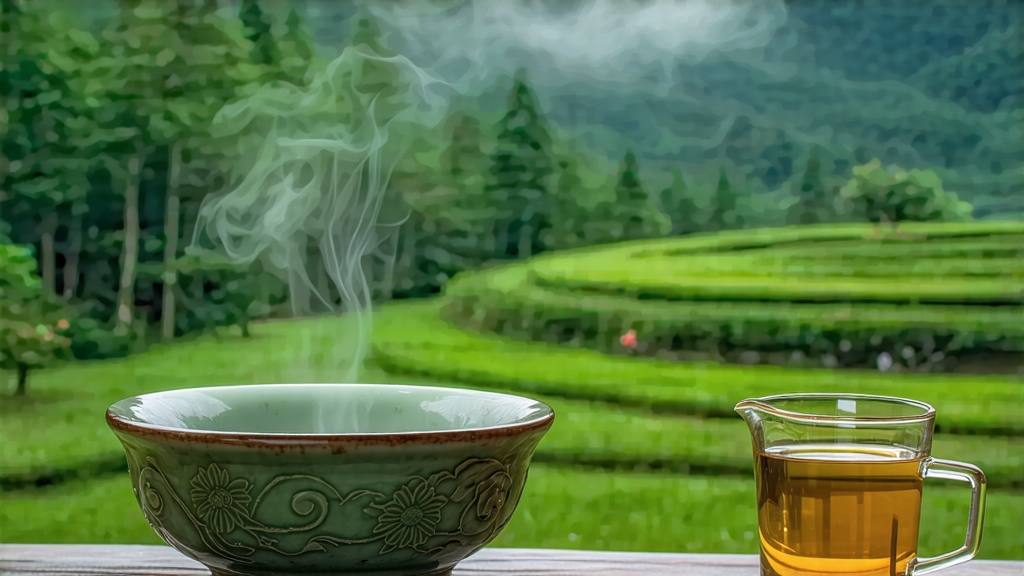
Tie Guan Yin, literally “Iron Goddess of Mercy,” is the most celebrated sub-variety of Chinese oolong. Born in Anxi, southern Fujian, it has travelled from temple altars to Michelin-starred tearooms, yet its soul remains in the mist-veiled slopes of Gan De, Xiang Hua, and Long Juan. To understand China’s half-fermented teas, one must first listen to the legend of Guanyin’s iron statue, the midnight soil of red-clay terraces, and the percussive music of cloth-wrapped leaf against bamboo tray.
History: From Bodhisattva to Brand
Folklore places the cultivar’s birth in the 1720s, when a devout farmer named Wei Yin found a rust-colored iron effigy of Guanyin hidden beneath a tea shrub. In gratitude he pruned the bush, propagated it, and named the tea after the goddess. Qing-era tax records list “Anxi Wu Long” tributes arriving in Beijing by 1740; by 1860 Amoy merchants were compressing Tie Guan Yin into lead-lined chests for the London market. The 1980s saw a renaissance: state laboratories mapped its gene sequence, while village cooperatives re-embraced traditional charcoal finishing. Today the name is protected under China’s GI (Geographical Indication) law; only leaf picked within 24 townships of Anxi County may bear the title.
Cultivar & Micro-terroir
The original Hong Xin Wei cultivar bears a distinctive crimson petiole and serrated leaf tip. Grown at 400–1,000 m on weathered granite soils, the plant develops slowly, accumulating amino acids and floral volatiles. Diurnal swings of 10 °C between fog-cooled nights and sun-warmed afternoons create the “rock rhyme”—a mineral aftertaste once attributed solely to Wuyi cliff teas. Sub-gardens such as Gan De’s “ma tian” horse-field or Xiang Hua’s “shi gu” stone valley yield micro-lots that command prices higher than Grand Cru Burgundy.
Craft: The Eighteen-Step Choreography
- Picking: only the open-face standard—two leaves and a bud—between 10 a.m. and 2 p.m. when surface dew has evaporated.
- Sun-withering: 20–40 min on raised bamboo racks until leaf tips droop like jade earrings.
- Indoor cooling: transfer to conditioned rooms; enzymatic oxidation begins.
- Tossing: the signature “yao qing” or “shaking green.” Leaves are tumbled in wicker drums to bruise margins while keeping veins intact; oxidation proceeds 30–40 %.
- Fixing: a 280 °C wok kill-green arrests enzymes within 90 s, locking in floral aromatics.
- Rolling: cloth-wrapped bundles are kneaded on rattan mats, twisting leaves into dragonfly-head pellets.
- Baking: low-temperature charcoal ash ovens at 70 °C for 3 h reduce moisture to 8 %.
- Refining: stems and yellow flakes are winnowed by hand; final moisture adjusted to 4 %.
A modern “light-fragrance” (qing xiang) style skips charcoal, preserving bright lily notes, whereas the “strong-fragrance” (nong xiang) route repeats baking three times, yielding chestnut and honey depths.
Chemical Signature
Gas-chromatography reveals a spectrum dominated by linalool, geraniol, and indole—molecules shared with jasmine and orange blossom. The partial oxidation converts catechins into theaflavins, giving a coppery infusion that carries only 12–18 mg caffeine per 150 ml, lower than green tea yet higher than most black teas. The lingering sweetness, or huigan, is attributed to γ-aminobutyric acid (GABA) formed during the tossing phase.
Grades & Market Forms
Anxi classifies Tie Guan Yin into five official grades:
- Supreme (te ji): single-garden, spring pick, 30 % oxidation, charcoal finished.
- Grade 1: blended spring and autumn leaf, 25 % oxidation.
- Grade 2–3: machine-assisted rolling, summer leaf, higher tannin.
- Commercial: fannings used in bottled beverages.
Compressed “brick” Tie Guan Yin, invented for the Belt-and-Road